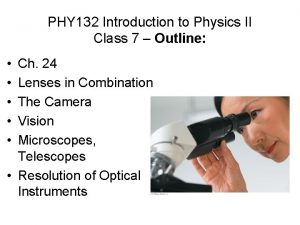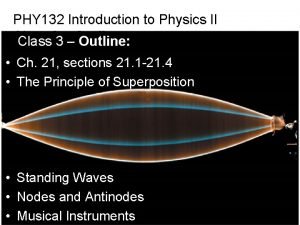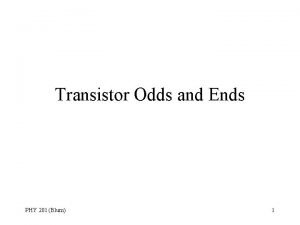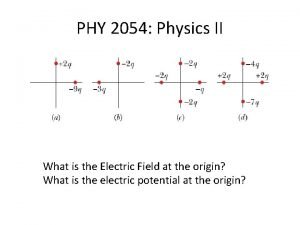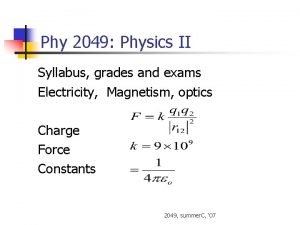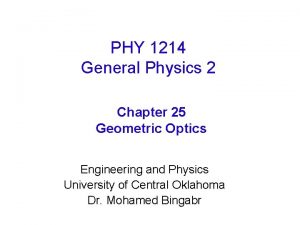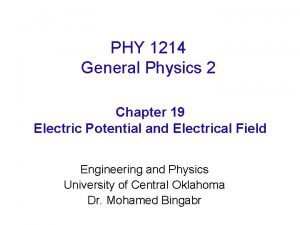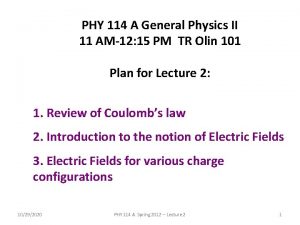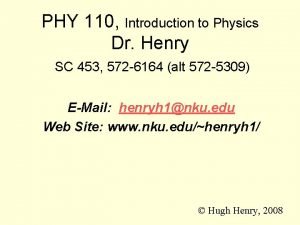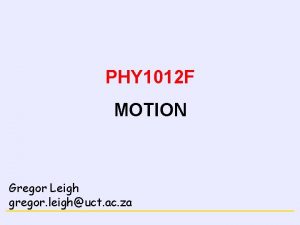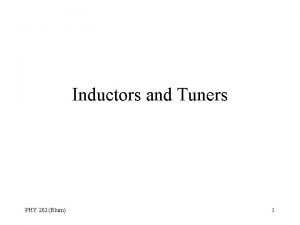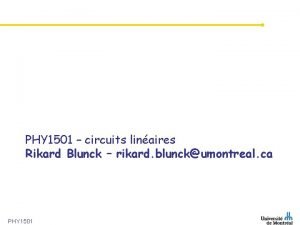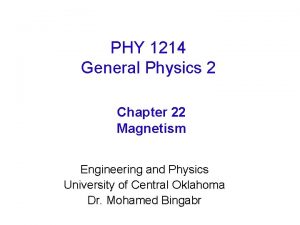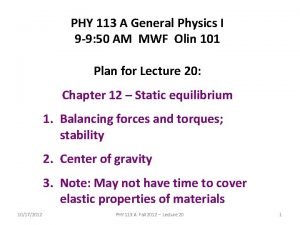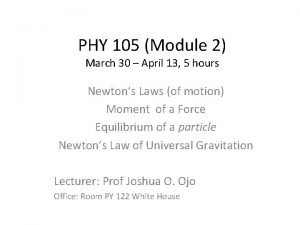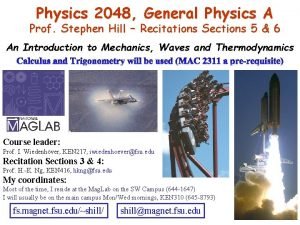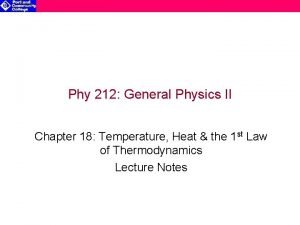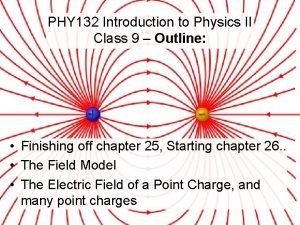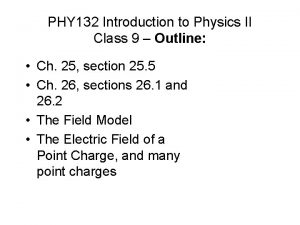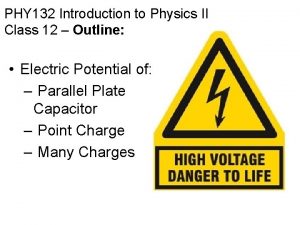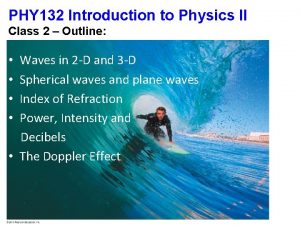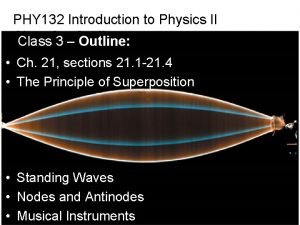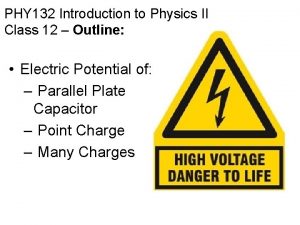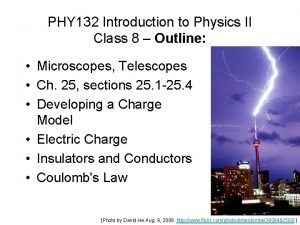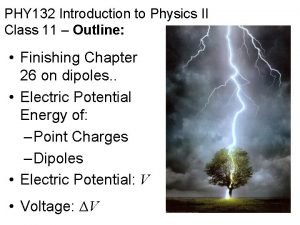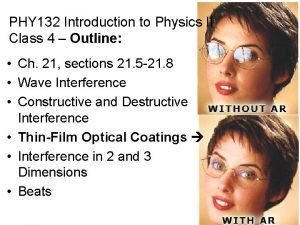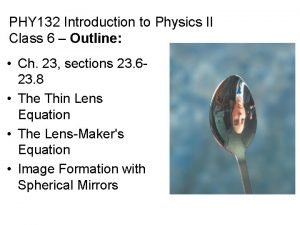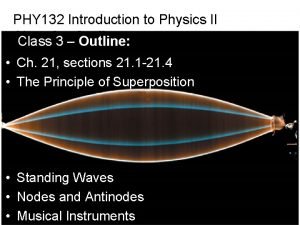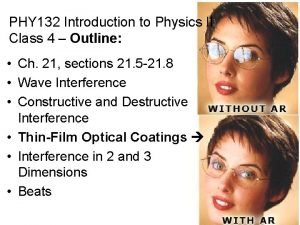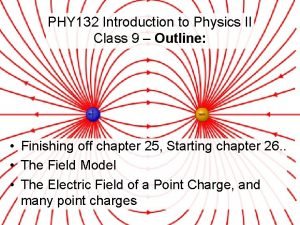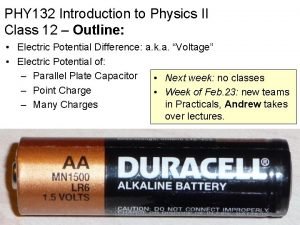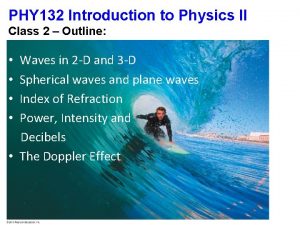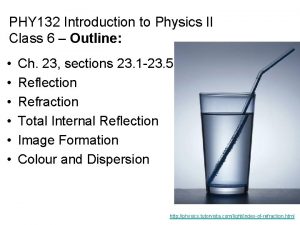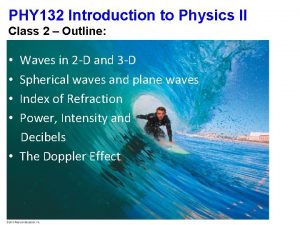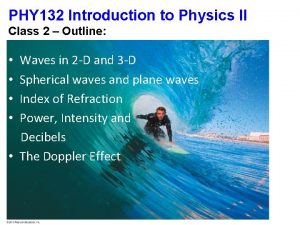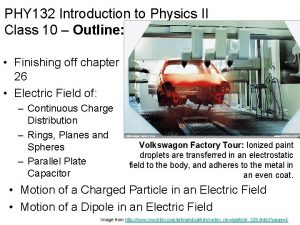PHY 132 Introduction to Physics II Class 4
































- Slides: 32

PHY 132 Introduction to Physics II Class 4 – Outline: • Ch. 21, sections 21. 5 -21. 8 • Wave Interference • Constructive and Destructive Interference • Thin-Film Optical Coatings • Interference in 2 and 3 Dimensions • Beats It’s my birthday! I am 43 today!

Clicker Question Two loudspeakers emit sound waves with the same wavelength and the same amplitude. Which of the following would cause there to be completely destructive interference at the position of the dot? (zero resulting amplitude) A. B. C. D. E. Move speaker 2 forward (right) 1. 0 m. Move speaker 2 forward (right) 0. 5 m. Move speaker 2 backward (left) 1. 0 m. Nothing. Destructive interference is not possible in this situation.

Class 4 Preclass Quiz on Mastering. Physics § This was due this morning at 8: 00 am § 672 students submitted the quiz on time § Two in-phase sources emit sound waves of equal wavelength and intensity. § 71% of students got: The interference is constructive.

Class 4 Preclass Quiz on Mastering. Physics § Two loudspeakers emit sound waves with the same wavelength and the same amplitude, a. The waves are shown displaced, for clarity, but assume that both are traveling along the same axis. At the point where the dot is, § 71% of students got: The amplitude of the combined wave is between 0 and 2 a.

Class 4 Preclass Quiz on Mastering. Physics § Two sound waves of nearly equal frequencies are played simultaneously. What is the name of the acoustic phenomenon you hear if you listen to these two waves? § 79% of students got: Beats.

Class 4 Preclass Quiz – Student Comments… § “You were saying in the pre-class video that during a destructive interference you get a straight line which accounts for no sound hear (silence), i just wanted to ask if there are real life examples to that, i just can't think of two sounds played together that would create silence. ”

Class 4 Preclass Quiz – Student Comments… § Harlow answer: It is really rare because pure sinusoidal waves are very rare. In reality, noise-canceling headphones must exactly recreate wave patterns and then invert them – this takes some complicated and fast electronics, and even still it isn’t perfect. § “OMG there's only 2 weeks left to the first term test !”

Announcement § Test 1 is Tuesday Jan. 27 h from 6: 00 -7: 30 pm. § Room To Be Announced § If you have a conflict with the above time, the alternate sitting will be from 4: 30 -6: 00 pm on Tuesday Jan. 27 th § To register, students should submit the Alternate Sitting Registration Form, available now in the PHY 132 S Portal course menu. § The location will be emailed no later than Jan. 26 to the people who have registered. § You have until Jan. 22 at 4: 00 pm to do it (the form will not be available after).

Piazza Question § “Does anyone know where can I find the answers for the conceptual questions in Knight? ”

Piazza Question § “What’s the difference between a sinusoidal wave and a standing wave? ”

Wave Interference • The pattern resulting from the superposition of two waves is called interference. Interference can be • constructive, meaning the disturbances add to make a resultant wave of larger amplitude, or • destructive, meaning the disturbances cancel, making a resultant wave of smaller amplitude.

Wave Interference D 1 a sin(kx 1 t + 10) D 2 a sin(kx 2 t + 20) D D 1 + D 2 § The two waves are in phase, meaning that D 1(x) D 2(x) § The resulting amplitude is A 2 a for maximum constructive interference.

Wave Interference § The two waves are out of phase, meaning that D 1(x) D 2(x). § The resulting amplitude is A 0 for perfect destructive interference.

The Mathematics of Interference As two waves of equal amplitude and frequency travel together along the x-axis, the net displacement of the medium is: The amplitude depends on the phase difference

The Mathematics of Interference • • The amplitude has a maximum value A = 2 a if cos( /2) 1. This is maximum constructive interference, when: where m is an integer. • Similarly, perfect destructive interference is when:

The Mathematics of Interference § It is entirely possible, of course, that the two waves are neither exactly in phase nor exactly out of phase. § (as we learned from today’s pre-class quiz!)

• • Thin-Film Optical Coatings Thin transparent films, placed on glass surfaces, such as lenses, can control reflections from the glass. Antireflection coatings on the lenses in cameras, microscopes, and other optical equipment are examples of thin-film coatings.

Application: Thin-Film Optical Coatings § The phase difference between the two reflected waves is: where n is the index of refraction of the coating, d is the thickness, and is the wavelength of the light in vacuum or air. § For a particular thin-film, constructive or destructive interference depends on the wavelength of the light:

Example A thin coating of Magnesium Flouride (Mg. F 2) is deposited on the surface of some eyeglasses which have an index of refraction of 1. 6. The Mg. F 2 has an index of refraction of 1. 38. What is the minimum thickness of the coating so that green light of wavelength 500 nm has minimal reflectance?

Interference in Two and Three Dimensions The mathematical description of interference in two or three dimensions is very similar to that of one-dimensional interference. The conditions for constructive and destructive interference are where Δr is the path-length difference.

Interference in Two and Three Dimensions

Example Two speakers, A and B, are “in phase” and emit a pure note with a wavelength 2 m. The speakers are side-by-side, 3 m apart. Point C is 4 m directly in front of speaker A. Will a listener at point C hear constructive or destructive interference?

Clicker Question 3 Two speakers, A and B, are “in phase” and emit a pure note with a wavelength 2 m. The speakers are side-by-side, 3 m apart. Point C is 4 m directly in front of speaker A. How many wavelengths are between Speaker A and Point C? A. 0. 5 B. 1. 0 C. 1. 5 D. 2. 0 E. 2. 5

Clicker Question 4 Two speakers, A and B, are “in phase” and emit a pure note with a wavelength 2 m. The speakers are side-by-side, 3 m apart. Point C is 4 m directly in front of speaker A. How many wavelengths are between Speaker B and Point C? A. 0. 5 B. 1. 0 C. 1. 5 D. 2. 0 E. 2. 5

Clicker Question 5 Two speakers, A and B, are “in phase” and emit a pure note with a wavelength 2 m. The speakers are side-by-side, 3 m apart. Point C is 4 m directly in front of speaker A. At point C, what is the path difference between the sounds received from speakers A and B, as measured in wavelengths? A. 0. 5 B. 1. 0 C. 1. 5 D. 2. 0 E. 2. 5

Clicker Question 6 Two speakers, A and B, are “in phase” and emit a pure note with a wavelength 2 m. The speakers are side-by-side, 3 m apart. Point C is 4 m directly in front of speaker A. At point C, there will be A. Constructive interference B. Destructive interference

Beats • Periodic variations in the loudness of sound due to interference • Occur when two waves of similar, but not equal frequencies are superposed. • Provide a comparison of frequencies • Frequency of beats is equal to the difference between the frequencies of the two waves. [image from http: //hyperphysics. phy-astr. gsu. edu/hbase/sound/beat. html ]

Beats • Applications – Piano tuning by listening to the disappearance of beats from a known frequency and a piano key – Tuning instruments in an orchestra by listening for beats between instruments and piano tone

Class 4 Preclass Quiz – Student Comments… § “In the end of the pre-class quiz, …You say that the beat frequency is 2 Hz, but the formula gave me 1 Hz. . . so are those two different frequencies? ” § The amplitude is slowly modulated with a frequency fmod = Δf/2 (reddashed line) § Beats are heard at fbeat = 2 fmod = Δf

Clicker Question 7 Suppose you sound a 1056 -hertz tuning fork at the same time you strike a note on the piano and hear 2 beats/second. What is the frequency of the piano string? A. B. C. D. E. 1054 Hz 1056 Hz 1058 Hz Either A or C Either A, B or C

Clicker Question 8 Suppose you sound a 1056 -hertz tuning fork at the same time you strike a note on the piano and hear 2 beats/second. You tighten the piano string very slightly and now hear 3 beats/second. What is the frequency of the piano string? A. B. C. D. E. 1053 Hz 1056 Hz 1059 Hz Either A or C Either A, B or C

Before Class 5 on Monday • Complete Problem Set 1 on Mastering. Physics due Sunday at 11: 59 pm on Chs. 20, 21. This is a rather long one so definitely get started early! • Please read Knight Ch. 22, sections 22. 1 -22. 4 • Please do the short pre-class quiz on Mastering. Physics by Monday morning at the latest. • Something to think about: Light is a wave. So is it possible for two beams of light to meet at the same place, destructively interfere, and produce darkness?
 Phy 132 lecture 10: ch30
Phy 132 lecture 10: ch30 Phy 132
Phy 132 Phy 131 past papers
Phy 131 past papers Phy 231 msu
Phy 231 msu Great orthogonality theorem in group theory
Great orthogonality theorem in group theory Rotational statics
Rotational statics Phy theorem
Phy theorem Phy113
Phy113 Phy 121 asu
Phy 121 asu Ddr phy architecture
Ddr phy architecture Phy 205
Phy 205 Nearsighted diverging lens
Nearsighted diverging lens Phy 2049
Phy 2049 Physics 2
Physics 2 Phy
Phy Phy
Phy Atm basics
Atm basics Phy
Phy Phy 2049
Phy 2049 General physics
General physics Phy 1214
Phy 1214 Phy
Phy Phy 110
Phy 110 Phy
Phy Felix connects a wire coil to an ammeter
Felix connects a wire coil to an ammeter Life phy
Life phy Rikard blunck
Rikard blunck General physics
General physics 2012 phy
2012 phy Phy-105 5 discussion
Phy-105 5 discussion Physics 2048
Physics 2048 Examples of convection
Examples of convection Phy 1214
Phy 1214
